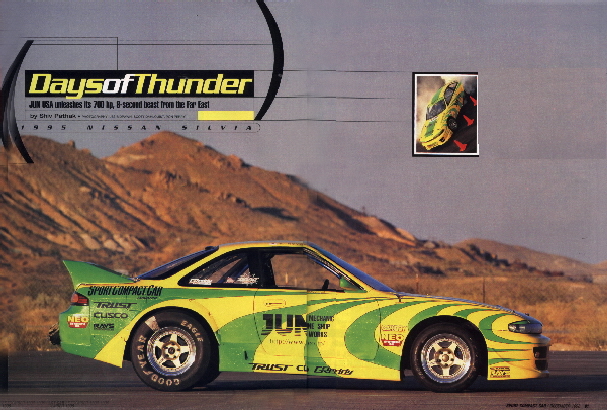
From the 12/98 issue of Sport Compact Car
Text by Shiv Pathak
Photos by Les Bidrawn, Scott Dahlquist, Ron Perry
These are the days of thunder for the small-displacement engine as quarter-mile records continue to be shattered at tracks across the United States by these modem-day muscle cars. The biggest impact was witnessed by a national television audience during the McMullen Argus/SEG Motorsports Pay-Per-View Detroit vs. the Imports broadcast earlier this year, where eight of quickest Japan-badged sport compacts went head-to-head against vintage big-block V8s from Detroit. med with high-tech gadgetry and even higher boost levels, e imports prevailed in showman-like fashion.
Between the tire smoke. glamour, and frenzy, a Nissan Silvia rolled out of an enormous enclosed trailer adorned with the JUN USA and Sport Compact Car logos. Shipped from Tokyo, the yellow and green colored Silvia (essentially the Japanese version of the 240SX) proceeded slowly to the starting line for an exhibition pass.
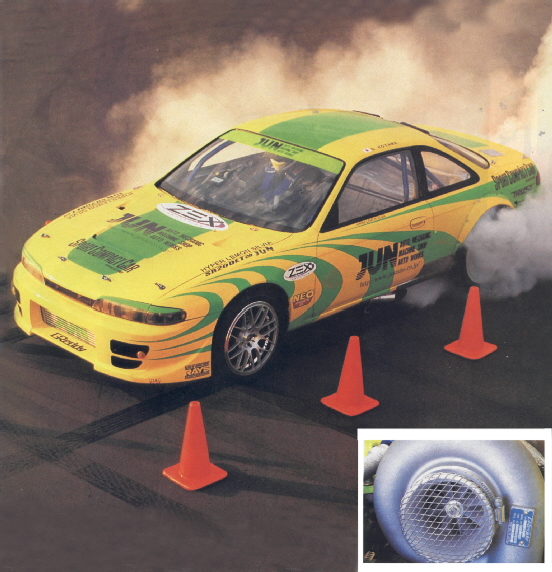
Equipped with one turbocharger bolted to an in-line four, the "hyper lemon" Nissan was quickly dismissed as just another brightly colored newcomer trying to learn the ropes of import drag racing. This couldn't have been further from the truth. WAAAH......VROOOOMM! In just over nine seconds (9.23 to be exact), it was over. The Silvia tripped the lights at a staggering 151.816 mph, setting the lowest E.T. and providing the most anticipated run of the day! More impressive was the fact that this was the first time the car had ever been run in an American-style drag race. In Japan, the cars are run one at a time, not side-by-side in head-to-head competition. With more track time and minor suspension tweaking, 8- second runs are well within reach.
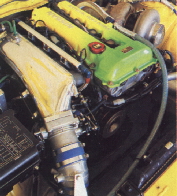
Compared to the other cars that managed to break into the 9s, the JUN Silvia looked somewhat understated. The launch was essentially drama-free. The Silvia barely squatted as the big slicks acquired traction. Seconds later, the car was heading towards the far end of the track, under control, but fighting for traction. No strange noises from the engine and no erratic steering corrections from the driver. In action, the Silvia looks more tame than most 12- second cars.
JUN was established in Japan back in 1946, and unlike other aftermarket companies, JUN is anything but a simple mail-order company. Making a name for itself with its close involvement with factory team racing, JUN quickly dominated the Japanese aftermarket with its track-tested, OEM-quality competition products.
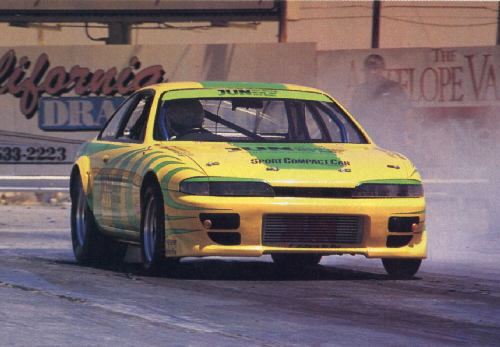
JUN's Japan-based vice-president and fearless driver, Sosumu Koyama (pronounced sue-sue-moo, ko-yah-mah) is a highly accomplished drag racer and a lifetime member of the 2OO-mph club. In 1991, he piloted JUN's Bonneville land speed car at 260 miles per hour! JUN's crew chief Kazuhiro Fujimoto set another Bonneville record when he drove their Hyper Lemon Skyline 233 miles an hour (see Gone Warp Speed, March 1998).
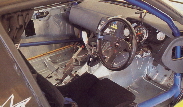
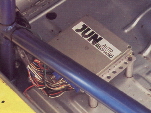
Judging from the accomplishments, the 150-plus mph trap speed in the quarter- mile isn't very daunting. JUN's drag car began its life in Japan as an unassuming, stock 1994 Nissan Silvia. Working very closely with Nissan Corporation, JUN purchased the unpainted bare-meal Silvia right off the production line. During its first three months of life, it was transformed by JUN's team of engineers from a high-performance coupe powered by Nissan's Japan-market turbocharged SR20DET engine, to a one-of-a-kind, 700- hp drag car. Three months is not a long time, but JUN's engineering team has learned much from their work on their hideously powerful Hyper Lemon Skyline GTR and Super Lemon Honda Civic. JUN USA, which was established in February of 1998, refused to let the Silvia touch our shores until the team demonstrated that it could consistently run 9-second quarter-mile times. The Silvia's overnight success in Japan paved the way for its Trans-Pacific voyage to the U.S. During secret test session in Palmdale, Calif., and fresh off the boat, the Silvia ticked off a conservatively driven 9.97-second run at 137 mph. This was immediately backed up by three consecutive nine second blasts, the fastest of which was a 9.532 at 146.1 miles per hour.
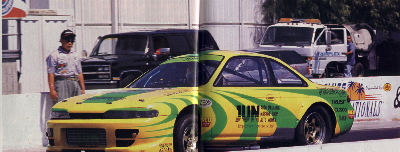
Weighing in at nearly 2200 Ibs, this Silvia is no carbon fiber-clad lightweight. In fact, the chassis is nearly stock. Aftermarket body panels consist mainly of a Fiberglas hood and front bumper. Oversized fender flares are necessary to house the enormous rubber required to channel 700- plus hp to the tarmac. That is the extent of the modifications made to fit the slicks, however, the car is not tubbed and still has the original multi-link rear suspension. The fact that JUN is able to reliably coax such copious amounts of horsepower out of Nissan's SR2ODET block is remarkable. Perhaps the most innovative modification was JUN's unique iron cylinder liner. To install the heavy-duty liner, JUN bored out the stock aluminum block. Not only does this upgrade add much need- ed displacement, JUN's iron sleeve also strengthens the block considerably. Prior to this breakthrough, the stock SR20DET block was guaranteed to fail at 450 hp. The cylinder liner modification was such a success in Japan, that it soon became standard fare for any SR2ODET motor producing an excess of 500 hp. JUN's forged stroker crank is another masterpiece of design and construction. The new crank lengthens the stock stroke by 4 mm. Stroked engines not only enjoy more low-end torque, they also improve turbo spool up time by increasing exhaust gas energy. JUN's liner and stroker modification bump the engine's displacement from 2.0 liters to approximately 2.2 liters.
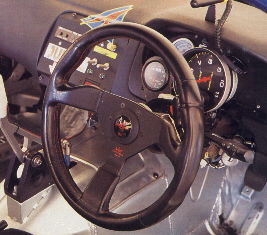
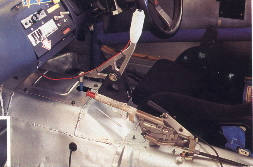
Another shortcoming of the SR20DET was its stock camshafts and valvetrain, which JUN found to be inadequate at engine speeds over 7000 rpm. To address this requirement, JUN developed a new solid camshaft with 0.452 inches of intake and exhaust lift. Both intake and exhaust duration share 280 degrees of duration. JUN also installed titanium retainers custom valve springs, and special rocker arms. JUN adjustable cam sprockets are utilized for fine-tuning. The end result is an engine that can efficiently spin in excess of 9OOO rpm with no mechanical failure. Under the hood, an enormously conspicuous GReddy T-88 force-feeds the engine which has a relatively high 8.3:1 compression ratio. With such extraordinary cylinder pressures, detonation is always a major concern. Addressing this serious issue, JUN uses an oversized, front-mounted air-to-air intercooler to reduce the chance of knock while maximizing power output. JUN's special plenum intake manifold is another outstanding achievement in the development of the SRZODET package. This custom-engineered manifold contributes to the Silvia's exceptionally broad torque curve and eliminates the high rpm "fall off" typical with Nissan's torquey SR2ODET engine. This manifold is available for the street Silvia in Japan, but unfortunately, it doesn't fit the front-wheel drive configuration of the SR20DE engine we get here.
Exhaust is scavenged by 1.68-inch mandrel-bent headers and passes through an unmuffled JUN exhaust system. Mounted behind the engine sits a Hewland sequential five-speed manual transmission. The clutch, shifter, and link- age are specially designed by JUN. Ohlin shocks with Eibach springs. The anti-roll bars, steering system and brakes are stock. Impressively, the CV joints and axles which flank the Cusco differential are all standard 1 Nissan parts! The Silvia's exterior, apart from its sparkling "micro flake" paint job, appears basically stock. The interior, on the other hand, remains void of all nonessentials, such as carpeting, trim, sound insulation, leaving only bare metal. Safely equipment includes a Simpson five-point harness, a full roll cage, and a Deist parachute system. JUN offers a host of modifications for the U.S. market, including a SR2ODET engine package for the Nissan 240SX. Not quite CARB-approved, it is only available for racing applications. It is nice to see that we have a viable option to the somewhat uninspiring truck-based motor currently offered in the domestic market 240SX. For those who want to piece together their own mega-powered dragstrip demon, nearly every upgrade used in the Hyper Lemon Silvia is offered by JUN.
JUN is also heavily involved with the Honda/Acura aftermarket. They have developed and manufactured proprietary, top-quality upgrades such as close ratio type R transmissions, competition clutches, and VTEC camshafts. Working intimately with Honda, JUN has the unique distinction of providing truly OEM-quality equipment that is race proven. JUN's race engines are incredibly durable, fully balanced, and comprehensively tested before they are available for purchase.
During the photo session where we captured the Silvia's unique ability to convert solid tire rubber into gaseous carcinogens, I convinced the good-hearted gentlemen from JUN to give me a quick (and stationary) lesson in drag racing the Silvia. They happily agreed to my selfish requests and pointed me toward the driver's seat. Like a spoiled brat loose in a toy store, I bolted toward the vehicle, barely managing to keep from tripping over my own tongue. I pulled open the door and planted my rear in the tightly bolstered Bride racing seat. The door closed, I was strapped in, and my impromptu tutorial commenced. From what I was taught, the driver is required to do a gratuitous burn-out to warm up the slicks and coax the audience into fits of horsepower-induced dementia. To do this, the driver's right hand activates the front wheel lock, which is mounted conveniently on the steering wheel. For the launch, the clutch is fully depressed and the sequential shifter is gently nestled into first gear. With judicious throttle management, engine is brought up to speed. As the lights turn green, the driver carefully lifts off the clutch, and attempts to control wheel spin to his best ability. Once under way, the proceeding shifts are clutchless and precisely timed.

The JUN Silvia's best time as of this writing is 8.887@154.65 mph clocked at Atco Raceway in New Jersey, and sponsors like Neo Oil, Craftsman Tools and others vying for a chance to share in its fame. Somehow, I don't think it gets much better than that... but who knows?